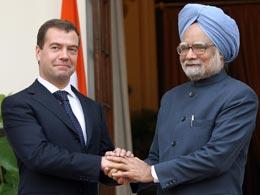|
||||||||||||||||||||
|
||||||||||||||||||||
Companies
racing into India's nuclear market
Deal between India and United States spurs investment rush.
K. S. Jayaraman & Declan Butler

Russian President Dmitry Medvedev and Indian Prime Minister Manmohan Singh.
RAVEENDRAN/AFP/Getty Images
Russia, France and other countries are rushing to capitalize on India's nuclear-power
programme, four months after the United States pressured the 45-nation Nuclear
Suppliers Group to end India's nuclear isolation. Arms-control experts strongly
criticize the Indo-US nuclear deal that set off the rush, saying it undermines
the Nuclear Non-Proliferation Treaty. India, a nuclear-armed state, has not
signed the treaty; those seeking to sell to it have.
India wants to increase the proportion of its electricity generated from nuclear sources from 2.8% to 25% by 2050. That would mean building 30 or more new reactors to join the 17 existing ones and the 6 that are under construction.
The Nuclear Power Corporation of India Limited (NPCIL) in Mumbai expects this month to finalize a total of US$15 billion in contracts with France's Areva group and Russia's nuclear-energy conglomerate Rosatom, says NPCIL chairman Shreyans Kumar Jain. The US companies Westinghouse and General Electric have not signed contracts, but are due this month to visit India and scout out possible locations for reactors. The NPCIL has readied four sites — one for each vendor — each capable of accepting eight to ten imported reactors.
On 5 December, Russian president Dmitry Medvedev signed a deal in New Delhi that paves the way for four more 1-gigawatt reactors over the next decade, in addition to the two that Russia is already building at Kudankulam in the southern state of Tamil Nadu. In November, the United Kingdom lifted its six-year-old blanket ban on exporting 'trigger list' items, including nuclear materials, to India. And in September, France signed an agreement similar to the US one to share nuclear technology and know-how with India.
Some formalities remain before the US and French agreements can be declared operational, says Ravi Bhushan Grover, director of strategic planning in India's Department of Atomic Energy (DAE) and a key negotiator of the Indo-US nuclear deal. The countries will have to exchange diplomatic notes confirming that all requirements have been met. The DAE must also file a declaration with the International Atomic Energy Agency (IAEA) listing civilian facilities to be placed under its safeguards; as part of the US deal, India agreed to separate civilian nuclear facilities from military ones and open to IAEA inspectors its present and future civilian facilities.
That is far from sufficient, say arms-control experts who argue that India should sign and ratify the Comprehensive Nuclear-Test-Ban Treaty, as well as cap the amount of fissile weapons material it produces. "India retains, deal or no deal, the capability to produce weapons-grade material at a far higher rate than it is believed to have ever done or to be likely to do," says Paul Nelson at the Nuclear Security Science and Policy Institute of Texas A&M University in College Station. The United States unilaterally brought India in from the nuclear cold without requiring it to make significant concessions, says Rebecca Johnson, director of the Acronym Institute for Disarmament Diplomacy in London.
Within India, DAE employees are concerned that an influx of proposed new reactors could lead to quality standards being compromised. The country's Atomic Energy Regulatory Board will have to inspect and clear several new reactors of different designs as they are approved. "Our primary concern is over safety," says A. Sathasivam, president of the National Federation of Atomic Energy Employees. Om Pal Singh, the board's secretary, says the problem is simply a lack of manpower. To deal with the new applications, the board intends to double its number of regulators within the next five years, he says.
And the NPCIL is losing staff, because many of its employees have been enticed into more lucrative jobs as consultants in the new nuclear rush. "Almost all our directors who have retired or who are going to retire in a few years have been grabbed by private companies at ten times my salary," says Jain. For instance, his predecessor, V. K. Chaturvedi, now heads the nuclear group at Reliance Infrastructure in Mumbai, and some present and former NPCIL engineers are in the process of forming nuclear-consultancy companies.
Meanwhile, domestic critics such as Annaswamy Narayana Prasad, retired director of the Bhabha Atomic Research Centre, and Padmanabha Krishnagopala Iyengar, former DAE secretary, claim that Indian nuclear scientists are giving up prematurely on their thorium research programme in exchange for a few uranium reactors from abroad. India has very little domestic uranium but one-quarter of the world's thorium reserves; its thorium research programme focuses on turning the material into fissile uranium-233 for use as reactor fuel. Fast breeder reactors, of the type under construction in Kalpakkam, would breed uranium-233 in thorium blankets surrounding a plutonium core. Recovering plutonium and uranium-233 from spent fuel is key to India's thorium programme, but, under the Indo-US deal, this has to be done in a dedicated plant under IAEA safeguards and with US permission.
Still, at least one overseas company is betting on thorium. Last
month, Thorium Power in McLean, Virginia, with a market capitalization of about
$40 million, established a joint venture with Punj Lloyd, an engineering company
in Gurgaon. The two companies plan to set up an investment fund and to act as
consultants to other companies looking to get in on the rush.